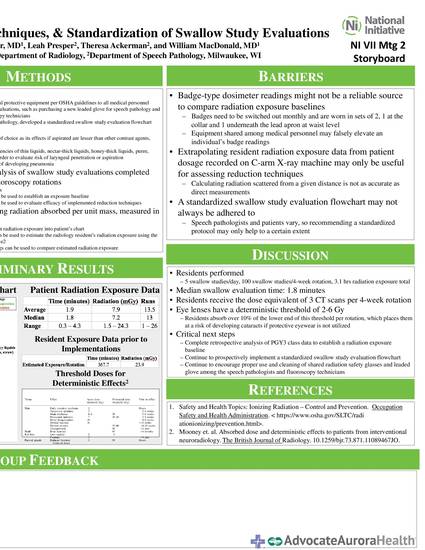
Background: Long-term exposure to ionizing radiation from fluoroscopic procedures can lead to deterministic and stochastic effects not only for the patient but for medical personnel as well. Swallow study evaluations are the most frequent fluoroscopic procedures performed and often require a speech pathologist, fluoroscopy technician, and radiology resident to be present in the room during the study. While C-arm radiography machines calculate the estimated absorbed radiation dose to the patient, cumulative radiation exposure badge data and baselines for medical personnel are difficult to interpret, track, and maintain.
Purpose: Establishing a fluoroscopic radiation exposure baseline in radiology residents may help in estimating other medical personnel exposure and monitoring future reduction techniques.
Methods: For the baseline radiation exposure analysis, fluoroscopic study data were retrospectively collected. Powerscribe is a radiology dictation software in which study reports are organized, and we sorted each resident’s studies into a database. Swallow study absorbed dose, which is ionizing radiation absorbed per unit mass measured in grays (Gy), is recorded with respect to the patient’s dosing. This amount was used to estimate the radiology resident’s radiation exposure utilizing an intensity calculated based off a distance of 2.5 m. Radiation exposure data were analyzed per individual residents in the current PGY3 class. Future methods include implementing reduction techniques and analyzing radiation exposure data in the current PGY2 class.
Results: Patient radiation exposure data per swallow study evaluation averaged 1.9 minutes (median: 1.8 minutes, range: 0.3– 4.3), where the average radiation exposure was 7.9 mGy (median: 7.2 mGy, range: 1.5–24.3). Residents performed approximately 5 swallow studies/day, or 100 swallow studies/4-week rotation. By utilizing an intensity calculation of Intensity = 1/distance2 , estimated resident radiation exposure over 8 weeks (2 × 4-week rotations) was 367.7 minutes (6.1 hours) and 23.9 mGy.
Conclusion: In residents, exposed areas of skin receive an ionizing radiation dose equivalent to 3 computed tomography scans per 4-week fluoroscopy rotation. Eye lenses have a deterministic threshold of 2–6 Gy. Residents absorb more than 10% of the lower end of this threshold during their first year of radiology training. Speech pathologists and fluoroscopy technicians without protective equipment could be at similar risk levels.
Brown MA, Reimer S, Presper L, Ackerman T, MacDonald W. Radiation Exposure, Reduction Techniques, & Standardization of Swallow Study Evaluations. Alliance of Independent Academic Medical Center – National Initiative VII Meeting #2 Storyboard. March 27-28, 2020. Austin, TX. [Meeting Canceled COVID-19].
Brown MA, Reimer S, Presper L, Ackerman T, MacDonald W. Radiation exposure, reduction techniques, and standardization of swallow study evaluations. Poster presented at: Aurora Scientific Day; May 20, 2020; virtual webinar hosted in Milwaukee, WI.

Radiology Residency Program
Speech Pathology